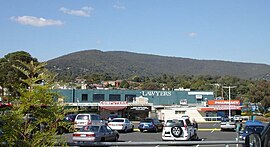Boronia, Victoria
|
Boronia Melbourne, Victoria |
|||||||||||||
|---|---|---|---|---|---|---|---|---|---|---|---|---|---|

Looking east towards One-tree Hill
|
|||||||||||||
| Coordinates | 37°51′43″S 145°17′10″E / 37.862°S 145.286°ECoordinates: 37°51′43″S 145°17′10″E / 37.862°S 145.286°E | ||||||||||||
| Population | 20,825 (2011 census) | ||||||||||||
| • Density | 1,827/km2 (4,731/sq mi) | ||||||||||||
| Postcode(s) | 3155 | ||||||||||||
| Elevation | 120 m (394 ft) | ||||||||||||
| Area | 11.4 km2 (4.4 sq mi) | ||||||||||||
| Location | 32 km (20 mi) from Melbourne | ||||||||||||
| LGA(s) | City of Knox | ||||||||||||
| State electorate(s) | |||||||||||||
| Federal Division(s) | |||||||||||||
|
|||||||||||||
Boronia is a suburb of Melbourne, Victoria, Australia, 32 km east of Melbourne's Central Business District in the local government area of the City of Knox. At the 2011 Census, Boronia had a population of 20,825.
The area was originally occupied by the Wurundjeri, Indigenous Australians of the Kulin nation, who spoke variations of the Woiwurrung language group.
Prior to European settlement, Boronia and surrounding suburbs were often visited by Aborigines from the Westernport and Yarra Yarra tribes, hunting during the summer months in the Dandenong Ranges and its foothills. The Wurundjeri people of the Kulin nation are the acknowledged traditional custodians of the land on which Boronia and all of City of Knox is located (source: Knox City Council publication).
In its early days of European settlement, Boronia was predominantly an orchard, flower growing and farming area.
Boronia was named in 1915 by local Councillor A. E. Chandler (prior to this, Boronia was considered part of Bayswater). Chandler named the suburb Boronia after the plant, boronia, which grew on his property at The Basin. The plant was discovered by Ferdinand von Mueller, an Austrian botanist, who came to Australia during the colonial period.
Boronia railway station opened in 1920, leading to an influx of residents and Boronia Post Office opened on 1 October 1920. A further influx occurred in the 1960s and 1970s.
The flowers most impressive historical building is Miller Homestead. Originally built in 1888 for John Miller, who was originally from Bayswater, London and the first president of the Shire of Fern Tree Gully (from which City of Knox separated in 1963) and Justice of the Peace. The original property included stables and horse training facilities and was over 77 acres (310,000 m2) in size. The property was sub-divided in 1971. Miller homestead is classified by the National Trust of Australia (Vic).
...
Wikipedia

